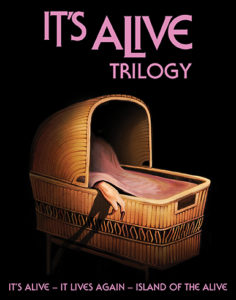
For roughly the last twenty years, I’ve engaged in a deep dive into the filmography of genre film legend Larry Cohen. I have watched every film he directed and nearly every one he has written multiple times (yes, even WICKED STEPMOTHER). I have written close to one hundred reviews of films he has worked on, think pieces about the thematic concerns that link those films, and other ephemeral thoughts that do not fall into any concrete style of film criticism or analysis. If you have read any of these pieces here at DAILY GRINDHOUSE, on my personal blog, on other film review sites, or even in academic film studies texts, you know that I love IT’S ALIVE more than any other film in existence (even more than PHANTASM). But for those few of you out there who do not know the obsessive depths of my love for the films of Cohen and IT’S ALIVE—in particular—here is an opinion that should make it crystal clear:
Even though it is not an adaptation of Frankenstein, IT’S ALIVE is the best Frankenstein adaptation ever made.
The films in the IT’S ALIVE trilogy came out several years apart. You can see this not just in content, but in the wildly veering tones from one entry to the next. While the first film is indisputably the best of the series, the sequels hold their own quirks and weird spins on the potentially tasteless premise of mutated babies born with fangs and claws that kill when threatened.
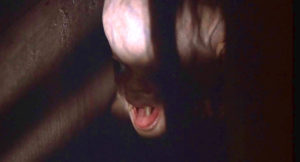
IT’S ALIVE tells what seems like it should be a straightforward monster run amok tale. But if you’ve seen any of Cohen’s better films, you know he has other things on his mind than just making a monster movie and that he is simply using a basic genre premise to get to meatier ideas.
After a striking title sequence that finds one, then two, then three, and more flashlights shining out of darkness until there are dozens of searching beams of light shooting out at the viewer while Bernard Herrmann’s wonderfully bombastic score sets a tone of impending doom, the film settles down to an urgent, but relatable scene. Lenore Davis (Sharon Farrell) wakes her husband Frank (John P. Ryan) in the middle of the night because she is going into labor. Instead of panicking, the couple is joyful. They have an eleven-year-old son named Chris (Daniel Holzman), so they have been through this before. Frank drives Lenore to the hospital, they check in, and—since this is the early ’70s—Frank retreats to the waiting room to smoke cigarettes and play cards with other expectant fathers while Lenore does the heavy lifting in the delivery room.
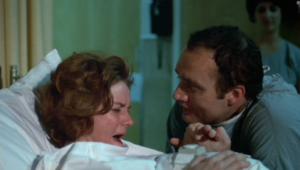
So far, so routine…until the baby is born and kills all the doctors and the nurses in the delivery room and escapes through a skylight, leaving Lenore screaming on the table, surrounded by bloody corpses.
Thankfully, the film does not try to tease out a false mystery that a maniac might have entered the delivery room, killed everyone, and then kidnapped the baby. The police—led by Lieutenant Perkins (Cohen regular James Dixon)—deduce very quickly that the baby was born with the claws and fangs of a wild animal and the survival instincts of a cornered grizzly bear. Frank is eager to distance himself as any relation to the baby, breaking Lenore’s heart since she feels that no matter what the baby is like, it is still her child.
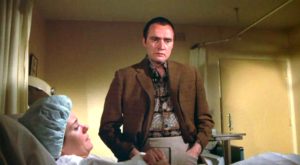
But no one involved in the situation is in a mood to think about the situation with the subtlety of Lenore’s observations—especially when the baby is killing those it feels are threatening it. As it becomes clear that the baby is working its way across Los Angeles to the Davis family home, Frank becomes more and more paranoid and declares to anyone who will listen that he wants the baby dead and he would only be too glad to handle the task.
Despite IT’S ALIVE being a film that is built around a mutated baby killing people, there is not a lot of physical carnage on display, but there is a ton of emotional violence happening between Frank and Lenore. Cohen builds dissects the implosion of their family unit at the same time that he throws Molotov cocktails at the harmful effects of pollution and doctors who are too cozy with the pharmaceutical industry.
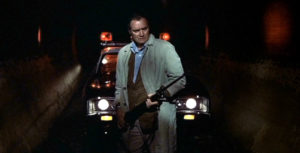
In one of his earliest special effects jobs, future Oscar-winner Rick Baker designed and sculpted the Davis baby, but it is barely ever seen and never shown moving due to the low budget he had to work with. This is actually better for the film since it allows Cohen to build suspense through visual tricks like the use of a slight kaleidoscopic effect to create the baby’s point of view and giving brief glimpses of it through the flashing red lights of a police car. Cohen states on many of the set’s bonus features that if he had shown the baby too much, it would have reduced the tension since the audience is no longer creating the full image of a monster in their heads.
What Cohen never states is that not showing the baby keeps the film from tilting into the realm of camp. IT’S ALIVE is played with straight seriousness. Once the shit hits the fan in the delivery room, there is not a moment of lightness to be found. Not only does the cast not wink at the camera, they dig into their roles like they are in a particularly visceral production of Hamlet. That treating the film with the utmost seriousness is what gives it a steady build of suspense. The alternately mournful and thrilling score by Herrmann lends a huge feel to what was a very low budget production and clues the audience into the tragic tone. And of course the performances by Ryan and Farrell shine a truthful, harsh light on the rapid decline of their relationship as they each deal with the situation in opposite ways.

Ryan, in particular, is so good as the film’s tortured “Dr. Frankenstein,” that he kicks the film up from simply being a very good horror film to something close to a Shakespearian tragedy. Watch how he takes Frank from a character obsessed with surface looks (he’s a public relations executive, so his wardrobe, car, and family all have to look top of the line) to a self-pitying mess full of anger and fear who wants to prove himself the tough guy he imagines himself to be by picking up a gun and tracking down his child. The transformation is subtle, but it’s all there in his face and a simmering self-hatred that expresses itself in casual cruelty to Lenore. His monologue comparing Frankenstein to his life because people confuse the name of the doctor as belonging to the monster could have fallen flat if not for Ryan nailing the perfect tone of deep, unceasing pain. I have said it before and I say it again now: Ryan’s performance in IT’S ALIVE is the best piece of acting I have ever seen.
For a film that only runs ninety minutes, Cohen packs a ton of content into it without it ever feeling rushed or over-stuffed. Frank’s arc of loving husband and father to a crazed man seeking to kill his own child to his eventual redemption could have been the entire movie and I would have been satisfied. But there is so much more to the movie. Lenore’s story supports and provides a counter-point to Frank’s as she proves to be the ultimate loving mother, putting herself in harm’s way to protect her violent child from everyone. Her arc, while not as showy as what Frank goes through, is just as tragic and Farrell plays it beautifully. The parasitic relationship between medical doctors, pharmaceutical companies, and medical research facilities is held up to scrutiny in two blunt, but probing scenes. And the general paranoia of an America knee deep in the war in Vietnam while being told every day in the newspapers that the President was a lying criminal is portrayed through trigger happy cops and a food chain of various people stabbing each other in the back to protect themselves.

The truly beautiful thing about IT’S ALIVE is how steadily it cranks up the tension and puts Frank through the wringer, culminating with a stunning ending that does not cop out. It’s a great horror film, a great tragic melodrama, and a great drama about a society crumbling under the pressure of rapid changes. It is flat out a great movie.
All three films in the new Scream Factory box set are taken from new 2K scans of the original film elements. The most striking differences in the first film from previous home video releases are nighttime scenes and moments captured in dark rooms that no longer look like they were shot with a candle and a small flashlight. Miraculously, the cleaner image does not take away from the ramping up of suspense and tension in IT’S ALIVE. Considering that getting a good look at the baby could have been disastrous for the film, the new image justifies Cohen’s very judicious use of Baker’s sculpture since there is still never a very good look given to it.
At the same time, the sharper transfer highlights just how nifty an idea it was for cinematographer Fenton Hamilton to use an extreme wide-angle lens to shoot many of the hospital interiors and some of the interior scenes at the Davis home. The warped look this choice gave the image in these moments makes the characters appear to be living in an alien world where mutant babies are born every day. In a strange way, Hamilton’s wall-eyed view helps ground the film in a mad reality.
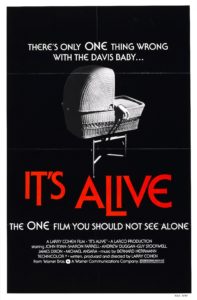
Cohen has a solo commentary track on the film that was ported over from the Warner Bros. DVD that was put out in 2004. Overall, it is an entertaining track with the enthusiastic storyteller enjoying talking about his time working with the legendary Bernard Herrmann toward the end of his life, crowing about how he convinced Warner Bros. to give the film a successful second release to the film three years after it did little business the first time around, and joking that he seemed to cast only Irish-American actors in the film. I do wish that he had a mediator or interviewer to prompt him from time to time because there are long stretches where he is silent and I could almost imagine him sitting in a room by himself getting caught up in watching the film. But who could blame him?
IT LIVES AGAIN (a.k.a. IT’S ALIVE 2) was released in 1978. I wish I could be as complimentary about it as I am toward the first film, but despite some strong scenes and ideas in its first half, it does not pack as much of a wallop as the first film. That said, it is still a fascinating film for both what it gets right and what it gets wrong in a third act that goes off the rails.
The naturalistic first scene of IT LIVES AGAIN is the best that the film gets.
Eugene (Frederic Forrest) and Jody Scott (Kathleen Lloyd) are the center of attention during a believably chaotic baby shower. Eugene not so subtly humble brags about his work as a lawyer for a Native American rights group to his friends while a very pregnant Jody brushes off concerns about putting her own career on hold to start a family. These conversations are captured in fragments as Cohen weaves together a party that is just a little too big to take in as anything other than a series of moments. It is largely played for gentle character comedy while establishing Eugene and Jody as our leads. But the comedy is undercut by the fact that Jody is pregnant in a series of films about mutated killer babies and the presence of Frank Davis (Ryan, reprising his role from the first film) at the baby shower.
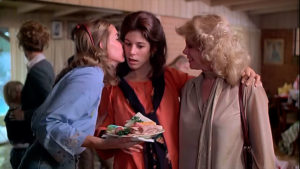
The introduction of Frank in the film is beautifully done. We simply get a quick glimpse of Frank watching as the couple opens gifts, smiling at their happy moment before showing sadness as he knows what is going to happen when Jody gives birth. When it finally becomes impossible for Eugene and Jody to ignore the fact that the last guest at the shower is Frank and that neither of them know who he is, the awkward conversation begins about who he is, they approach him for what turns out to be a very awkward conversation.
In an exposition dump that would be rough in the hands of a lesser actor than Ryan, Frank lays out a conspiracy theory that the federal government is working with obstetricians all over the country to do special tests under the guise of normal procedures to identify women who may be carrying one of the mutated babies. Frank claims that this special federal task force then commandeers the hospital during delivery and kills the baby at birth. He assures Eugene and Jody that this has already happened other times and that by playing along as someone the task force trusts, he has learned that they are targeting the Scott baby.
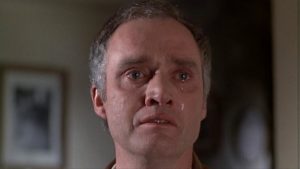
The clever thing about this opening is that it does manage to combine the necessary heavy lifting of explaining to the audience what has happened since the end of the first film and how those events are going to impact the plot of the current film by introducing the prickly dynamic between Eugene and Jody and showing how Frank has progressed as a character. The fact that Frank is the one delivering this bad news adds a touch of much needed gravity to the premise (which is more outrageous than the first film). We have seen how the events of IT’S ALIVE broke him and now we see how he has taken his broken heart and mended it by becoming something close to a zealot who will stop at nothing to save the lives of mutant babies.
Through a series of increasingly absurd scenes that involve mobile delivery units, a pair of shifty looking doctors, and a hostage situation, Frank does indeed manage to save Eugene and Jody’s baby. Eugene and the baby are smuggled to a research facility in Los Angeles run by Dr. Perry (Cohen regular Andrew Duggan, returning from the first film). Eugene is shocked to find out that there are two other babies at the facility. More shocking is the accelerated rate of growth and intelligence they show—including the ability to communicate with each other.

The first half of IT LIVES AGAIN, while coming close to spinning out of control at certain points, is thematically and tonally in line with the first film. Ryan is terrific again as Frank, believably playing the transformation he has gone through to become a crusader for his cause who borders on the insane (while holding a man hostage to get Jody transported to the mobile delivery truck, he literally yells at the police “We are protecting this woman’s right to have a baby!”—a line that could be construed as placing him in league with the kinds of zealots who protest at Planned Parenthood locations).

Beyond Frank’s fascinating arc, the film is fun when it gets into the continuing debate between characters about what has caused the mutant baby phenomenon. Frank is convinced that the babies are an evolutionary leap to deal with worsening pollution. Police Lieutenant Perkins (James Dixon, returning from IT’S ALIVE) suggests drug use. Mallory (John Marley), the shadowy federal agent in charge of the task force just thinks they’re aberrations that have to be killed before they take over the world and destroy the human race. It is fun that in the middle of a monster movie sequel, characters will just stop to talk philosophically about the bigger picture.

Rick Baker returned to design and create the babies. His efforts are definitely a big step up from the barely glimpsed Davis baby from the first film. While Cohen is still judicious in his use of footage of the babies, what is shown of them highlights creations that are more organic looking, move more realistically, and are capable of showing more facial expressions.
Unfortunately, the final thirty minutes of IT LIVES AGAIN falls apart. There is a line of demarcation for me when the film goes too far in an effort to shake up the formula. The result is to muddy the waters too much about if the audience should be on the side of the babies and those trying to save them or the side of those trying to destroy them. The other main problem comes in the form of Frederic Forrest as a leading man.
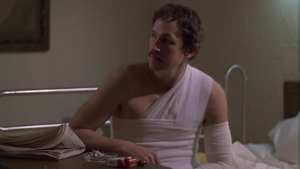
Despite Frank’s presence, Eugene and Jody are treated from the beginning as the leads of the film. Lloyd’s performance as Jody is spirited, funny, and despairing as the needs of the film dictates. But Forrest—despite the attempts of Cohen and Francis Ford Coppola, later—is just not a leading man. It is hard to tell if Eugene is written as an unceasingly sardonic, easily irritated jerk or if Forrest decided to stick to that single note in his performance. Quite frankly, Eugene is an unpleasant person to spend time with and Forrest’s performance truly is a drag on the film, especially in the third act when it becomes basically a two character film. If you need a shifty, inherently creepy supporting performance, Forrest is your guy, but as a morally conflicted yet loving husband, he is woefully miscast.
A finale that tries to play just as heartbreaking as the first film’s climax comes off as rushed and is far enough on the opposite side of the spectrum from satisfying that I can come close to saying I hate it. This was probably the sixth or seventh time I’ve watched IT LIVES AGAIN and this is the first time I’ve had such a strongly negative reaction to the ending.
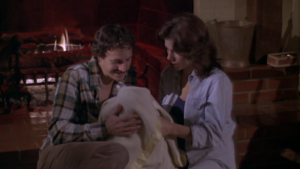
IT LIVES AGAIN does greatly benefit from the 2K scan. The film has a professional sheen to it that I have never noticed before. The Blu-ray presentation here really shows off the benefits of the film’s larger budget and what cinematographer Fenton Hamilton was able to accomplish with the larger (assumingly), more professional crew the extra money bought.
IT LIVES AGAIN sports another solo Cohen commentary that is also from the 2004 Warner Bros. DVD. This one is a little more candid as he explains how the sequel was rushed into production after the unexpected success of the first film’s re-release. He gets into the issues he had with the crew he was using for some shooting in Tuscon, AZ and how THE TEXAS CHAINSAW MASSACRE cinematographer Daniel Pearl swooped in at the last second to take over that location shooting to save the film. To hear Cohen tell it, the production sounds a little chaotic, but he seems relatively happy with the final result, praising Forrest’s work where I thought he was miscast, but lamenting the fact that he killed off a character when he could have used that person in the third IT’S ALIVE film he did not know was going to happen. Obviously, Cohen is a born storyteller, so the commentary track never drags, but it also feels like it could have been slightly more in depth than several sequences where he points out what was and was not shot in his house.
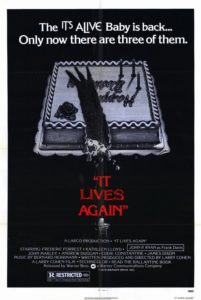
Given how frustrating I found the third act of IT LIVES AGAIN, you would think that I would hate 1987’s IT’S ALIVE III: ISLAND OF THE ALIVE. The film completely changes tones from the first two entries in the series, playing as far more comedic and silly for long stretches, with the government and pharmaceutical conspiracy theories amped up considerably. But I have a strange affection for ISLAND OF THE ALIVE that has almost everything to do with the presence of frequent Cohen muse (for lack of a better term) Michael Moriarty as the film’s lead.

After a brief prologue featuring the birth of one of the babies in the back of a cab that is intended to crank up the shock value, we are introduced to Stephen Jarvis (Moriarty), a journeyman actor and the newest father of one of the mutated babies. As the film opens, backed by a parents’ group, Jarvis is in court suing to stop what he sees as the unwarranted execution by the government of his child and four other babies in custody. After admitting to his lawyer that he’s “scared shitless” of his child, he still manages to make a passionate plea to the Judge (Macdonald Carey) that shows the children are indeed human and only attack when threatened. The Judge orders that the five children are to be placed on a deserted island in the Atlantic where they cannot hurt anyone and are allowed to develop in their own way.
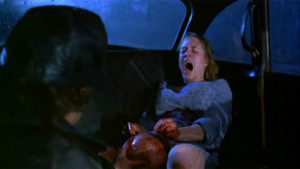
Satisfied that he has saved his child, Jarvis tries to pull his life back together, but finds the world will not allow it. His ex-wife Ellen (Karen Black) wants nothing to do with him and his lawyer serves up a massive bill that forces him to write a tell-all memoir since he can no longer get work as an actor because of how controversial he is. In a great scene, Jarvis is asked for his autograph at a cocktail party and he mentions that he had never been asked for his autograph over all his time as an actor. He signs it “Stephen Jarvis, the Father of the Monster” and then proceeds to go around the room introducing himself with that moniker and telling bad jokes about “the Jarvis baby.” Because Moriarty is so good at walking the line between sarcastic and honestly wounded, this breakdown scene manages to connect the tragedy of Cohen’s sincere early genre work with the more anarchic, satirical films he made in the ’80s.
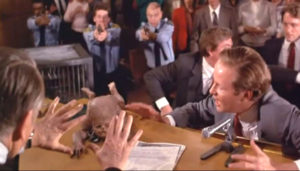
Five years go by with no new births of mutated babies. Jarvis bottoms out as a children’s shoe salesman and is recruited by Lieutenant Perkins (James Dixon again, the only cast member to appear in all three films). A group of scientists want to go to the island to study the development of the babies as they age, tranquilize one of them to take tissue and blood samples, and possibly bring one back to do a full autopsy. The group wants Perkins and Jarvis to go with them because they are the experts on the behavior of the children. Neither man is comfortable with the idea of going to the island, but they also don’t want any of the children killed so they join the expedition in an effort to serve as protection for both the children and the idiot scientists who cannot leave well enough alone.
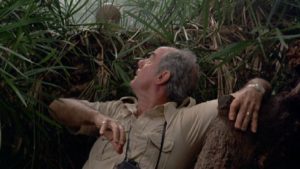
This is clearly a lot of heavy lifting to get around to what is promised in the title. But Cohen made ISLAND OF THE ALIVE during the stretch of films that ran from Q to THE AMBULANCE that found him at his loosest, funniest, and arguably most creative. Keeping in line with the other films he was making at the time, Cohen embraces the absurd and the chaotic, using a tongue-in-cheek style to plow through scenes of exposition and placing them between bizarre but hilarious bits of character building like Jarvis singing sea shanties on the boat to the island, Perkins slathering on sunscreen and complaining that his doctor told him not to be in the sun, and the two of them playing pranks on the scientists like they are bored children with nothing else to do. For a stretch of seven minutes in the middle of the film, it ceases to be an IT’S ALIVE movie and becomes Cohen’s version of a Marx Brothers comedy with Moriarty and Dixon as Groucho and Chico.

Inevitably, the plot-heavy second half of the film kicks in and—while still entertaining—it feels more perfunctory and less anarchic than the first half. Some of this is attributable to the rough effects work bringing the grown versions of the babies to life. The low budget definitely played a part in the downgrade from the quite good puppets that Rick Baker made for IT LIVES AGAIN to the obviously rubber masks and suits worn by actors here.
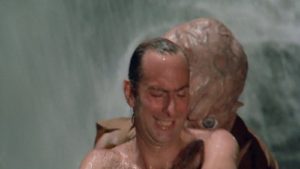
Also bringing the film down in the second half is the feeling that Cohen’s usual improvisational approach was not working as well this time around. There is always a special magic when Cohen and Moriarty work together and it is on display here as Moriarty gives Jarvis a bitter, sarcastic exterior, but lets the good heart of his character shine through when appropriate. But aside from Dixon (who is underutilized once the film gets to the island), the other actors are either too stiff or over-the-top. Black is the real culprit here. Normally a great, livewire presence on screen, her performance is shrill and obnoxious, which is a real problem in the third act when she is supposed to suddenly become a sympathetic character.
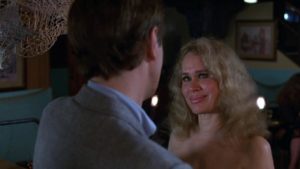
Given that it is the finale to the trilogy, the ending of ISLAND OF THE ALIVE is a bit of letdown. The final few scenes feel rushed and the conclusion, while less tragic and more enigmatic than the previous two films, fails to fully land as an emotional beat. Still, compared to the almost unforgivable final thirty minutes of IT LIVES AGAIN, I am much more willing to take the low-key, semi-comedic conclusion here as the end point of this series of films.
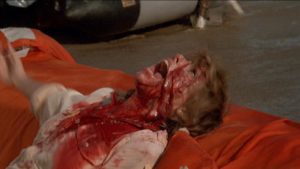
The 2K scan is very unforgiving of the rubber masks and suits in the third act, but it does allow the bright, primary colors of certain scenes set in a Florida beach resort town to really pop, highlighting the more comic book approach of ISLAND OF THE ALIVE that stands in stark contrast to what Cohen refers to as the first two film’s “color in black and white” aesthetic.
Once again, Cohen’s commentary track from the 2004 Warner Bros. DVD is used. It finds him reliably entertaining as he talks about how he embraced dark comedy in his films following the success of Q, explains that the film was part of an early effort by Warner Bros. to make films direct for the video market (it was part of a two picture deal that included A RETURN TO SALEM’S LOT, shot back-to-back with ISLAND OF THE ALIVE, featuring most of the same cast and crew) though it eventually was given a brief theatrical release, waxes poetic about the joy he has working with Moriarty, and—as always—engages in a defense of his shoot-from-the-hip style of filmmaking.
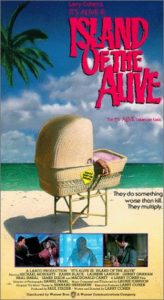
All three films come with the standard trailers and still galleries. The first film also includes TV spots and a radio spot that hilariously features dialogue from the film spoken by hammy radio actors who clearly do not understand the correct tone. IT’S ALIVE AT THE NUART: THE 40TH ANNIVERSARY SCREENING is included with the first film. It is a brief Q&A with Cohen in front of an audience at the screening, but basically everything talked about in the session can be found in the commentary tracks or in the short documentary COHEN’S ALIVE: LOOKING BACK AT THE IT’S ALIVE FILMS.
Found on the first disc, COHEN’S ALIVE is the best of the bonus features. Produced and directed by Steve Mitchell, it features interviews with Cohen, Moriarty, Dixon, Laurene Landon (who had a small part in ISLAND OF THE ALIVE), ISLAND OF THE ALIVE cinematographer Daniel Pearl, and more, the doc appears to be made up mostly of deleted scenes from Mitchell’s KING COHEN feature documentary. But that does nothing to lessen the fun of watching the cast members and crew chuckle to themselves and shake their heads at some of the goofier things Cohen made them do (Problem: the crew of the third film is sea sick on the boat? Solution: throw some fake blood on them and have them play dead extras as they lay on deck trying not to throw up.)
While the set is not nearly as comprehensive as I would have hoped and I wish Scream Factory could have brought Cohen in for new commentaries, I really cannot complain. The 2K scans are the best these films have looked on home video and the higher profile this release will give IT’S ALIVE makes the set worth owning. It’s a treat for audiences discovering these films for the first time and a reminder for hardcore Cohen fans of how much his tonal style changed as his career evolved.
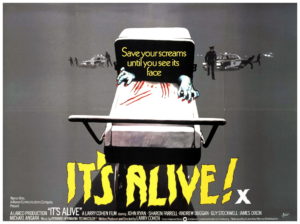
The IT’S ALIVE trilogy Blu-ray box set will be available from Scream Factory on May 15, 2018.
–Matt Wedge (@MovieNerdMatt)
Tags: Andrew Duggan, Bernard Herrmann, Daniel Holzman, Daniel Pearl, Fenton Hamilton, frankenstein, Frederic Forrest, It Lives Again, It's Alive, It's Alive 2, It's Alive III: Island of the Alive, James Dixon, John Marley, John P. Ryan, karen black, Kathleen Lloyd, King Cohen, Larry Cohen, Laurene Landon, Macdonald Carey, michael moriarty, Rick Baker, scream factory, Sharon Farrell, Steve Mitchell


No Comments